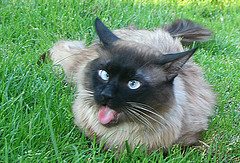Help Your Pet Skip Hairballs
Posted by Tomlyn on Apr 28th 2015
“Hairball! Major hairball!” - Snowbell, “Stuart Little 2”
 There are always a few cats that care more about their appearance than you do, namely those who excessively groom themselves throughout the day. Then there is that moment when you are thankful that you use a brush to groom yourself when you hear them hacking up a hairball in the other room.
There are always a few cats that care more about their appearance than you do, namely those who excessively groom themselves throughout the day. Then there is that moment when you are thankful that you use a brush to groom yourself when you hear them hacking up a hairball in the other room.
With Hairball Awareness Day approaching, here are a few tips on how to spot signs of hairballs and how to reduce the number of hairballs your pet leaves for you to clean up around the house.
What causes hairballs?
Hairballs are caused when a pet ingests hair into its digestive tract, usually when he or she grooms. While most hair particles are eliminated in the litter box, some sit on the stomach. As these hairs start to collect, they create a “ball” that can’t escape the body through the traditional route. That’s when your pet vomits.
How do I know if my pet has a hairball?
Hacking or vomiting large clumps of hair at a time, usually in a tube-shaped form, is the easiest way to tell if your pet has a hairball. There are some instances, however, when your pet will only produce bile when they vomit because their stomach was upset by the hair that is freely floating in the stomach. Even if you don’t see the hairball, your pet may still have one. And it will come up eventually!
What pets get hairballs?
Many people think that hairballs are found only in cats, and in many cases, they are, since cats are known for constantly grooming themselves. However, ferrets can get hairballs for the same reasons as cats, and they’re likely to show the same symptoms if they have one.
How can I prevent or reduce the number of hairballs my pet gets?
- Groom your pet. According to the American Society for the Prevention of Cruelty to Animals, grooming your pet to decrease their hair intake can prevent hairballs or keep them from occurring so often.
- Give your pet a new toy to divert their attention. Pets sometimes groom excessively when they’re bored. Providing new toys (or rotating existing toys to keep your pet interested) may keep them from grooming too much when you’re not home to entertain them.
- Try a lubricating gel, like Tomyln’s Laxatone hairball remedy. Gels or chews like Tomlyn’s Laxatone will help push the hairs down the intestinal tract to be eliminated in the litter box. Click here to learn more about hairball remedies or to purchase one. They come in a variety of forms and flavors, and Tomlyn’s Laxatone Gel is also available for ferrets.
Don’t let a hairball slow your pet down. Use these tips to help prevent hairballs and spread the word about Hairball Awareness Day on April 25.
